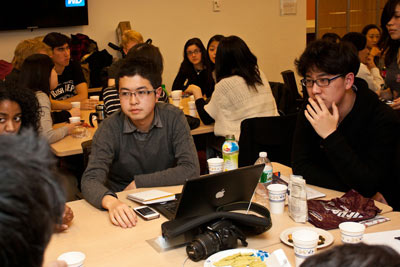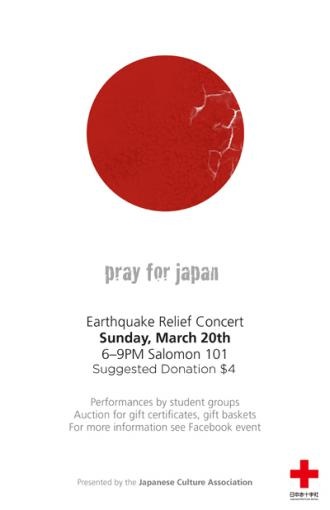Japan Earthquake and Tsunami Response
The end of the beginning: rebuilding Japan
Natural disasters to our community are just like injuries to our body; even with serious treatment, deep injuries will leave scars, at times resulting in permanent disablement or disfigurement. While the pain may fade away as the time passes by, the damaged part still remains vulnerable. Yet the community can grow to be more resilient so that it can withstand similar shocks in the future.
 |
| Discussion session |
Seventeen Japanese students, traveling in the US on a tour organized by Human Rights Watch Tokyo, visited Brown to share their perspectives on the most recent development concerning last year’s disaster. The intimate session with over 30 Brown students and 2 professors included presentation by two of the visitors with direct experience in the afflicted areas and a lively discussion among participants sharing their perspectives on conditions surrounding the immediate aftermath of the disaster as well as the more long-term relief efforts that continue today.
Mr. Sasaki, a student from the afflicted area, shared his complex emotion towards the event. In fact, on March 10th, the day before the disaster hit, he was in the area. “It is a weird feeling to see all the temporary housings around my hometown where there used to be only fields,” he said. He presented the images of train station before and after: before, it looked like a peaceful and well-ordered rural train station in Japan, but after, the entire station turned into rubble. Then, Ms. Ishikawa, the coordinator of this trip, explained her work in the afflicted area, such as legal assistance. She also articulated how local people are already feeling scared about ever-decreasing number of volunteers coming into the region to help.
Discussion session
Discussion sessions incorporated various aspects of the issues surrounding the disaster, such as media coverage, the Japanese students’ volunteer experiences, and nuclear melt-down. Most importantly, we asked the question of how the world can learn from the event to lessen these future disasters. “I take it for granted that people volunteer and do something. I think we need to do more than that,” one Japanese student said.
Due to the students’ enthusiasm and heated discussion, the Japanese students missed the bus they had initially planned to take to return to Boston at 7pm — instead, they had to rush to the station to catch a train at 9pm. The farewell marked the end of the beginning for a series of events that the Japanese Cultural Association has organized to commemorate 3.11: on March 1st, the maritime officials who participated in Operation Tomodachi will give a lecture; on March 11th, the date the M9.0 Earthquake hit, there will be commemoration on the main green by presenting the paper cranes; on March 20th, two high school students orphaned by the tsunami will come share their speech that they made at the Davos Conference earlier this year; in April, as a part of week-long tour among five universities in the East Coast, local NPO directors will critically assess the progress that has been achieved so far and that will be required going forward.
As the session with Japanese students also reminded us, the one year anniversary of the 3.11 disasters also marks the end of the beginning for the recovery in afflicted areas: most of the debris has been cleared out — yet there is still a long way ahead: reconstruction of entire villages; reallocation of entire communities; employment of the displaced; rebirth of industries; emotional care for the afflicted. Although many of us have not gone to the afflicted areas and may feel distant from the issue, the session reminded the importance of continued concern for the region left with the deep scars.
